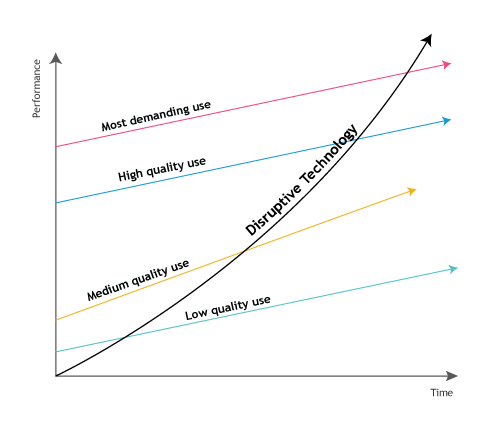How many industry giants were dethroned by disruptive innovation? Companies like Blockbuster, Kodak, and Toys R Us fell to emerging competitors that initially seemed insignificant. Disruptive innovation often comes from smaller companies introducing new products or services that meet customer needs in new and efficient ways. The big players in the market typically underestimate these disruptors, failing to see them as serious competition. By the time they recognize the threat, it’s often too late—the underdog has made them obsolete.
In this article, we'll examine how disruptive innovation can reshape industries and lure away a dominant company's existing customers. Whether you're a business leader at an established corporation or an innovator at a small startup, understanding the theory of disruptive innovation is vital to remain relevant and gain market share. This article provides real-world examples of disruptive innovation to illustrate the potential to tap into overlooked markets. These examples also highlight the common pitfalls of incumbent companies, how they become complacent and believe they'll retain profitable customers by merely improving existing products and services. But first, let's outline the theory of disruptive innovation.
What is the theory of disruptive innovation?
The concept of disruptive innovation was coined by Harvard Business School's Professor Clay Christensen in a 1995 article titled Disruptive Technologies: Catching the Wave. According to Christensen, the theory of disruptive innovation explains how smaller, resource-limited companies can upend established market leaders by targeting overlooked customer segments. While the market leader develops products or services in order to appeal to their most profitable customers, that leaves a gap for newcomers to lure underserved markets by offering lower-cost solutions. Eventually, the newcomers move upmarket by appealing to the incumbent’s mainstream customers, taking away the big player’s primary source of revenue, often displacing them. This is what makes innovation disruptive—it reshapes consumer expectations, and forces entire industries to evolve or risk obsolescence.
Christensen's work emphasizes that disruption often arises not because incumbents fail to innovate but because they focus too narrowly on their existing high-value segments, leaving room for more agile competitors to thrive. Christensen's disruptive innovation theory suggests that no company, regardless of size or legacy, is safe from the threat of innovative newcomers.
The reason why it is so difficult for existing firms to capitalize on disruptive innovations is that their processes and their business model that make them good at the existing business actually make them bad at competing for the disruption.
- Clayton M. Christensen
Initially, these innovations are often dismissed by industry leaders as underdeveloped. However, disruptors enhance their offerings over time, ascending the market to meet, and occasionally exceed, the expectations of the most demanding customers. Christensen regards this process as essential for the longevity and evolution of markets.
Disruptive innovation theory in a nutshell:
- Emergence in low-end markets: Disruptive businesses often begin by catering to a low-end or neglected segment of the market.
- Initial inferiority: These new entrants typically start with a product or service that the mainstream market views as inferior.
- Upward trajectory: Over time, these disruptors enhance their offerings, gradually appealing to more demanding customers.
- Market transformation: Eventually, these entities redefine the market, drawing in a significant portion of the customer base, including those of established players.
Examples of disruptive innovation
Netflix: A classic disruption story
Netflix's journey is the epitome of disruptive innovation. It began as a mail-in DVD service, appealing to a niche market ignored by then-giant Blockbuster. This segment included those indifferent to new releases, early DVD adopters, and online shoppers.
Netflix's initial online DVD-by-mail rental model allowed customers to choose movies from the comfort of their homes. By contrast, Blockbuster's model required people to visit physical stores to rent and return videos. Blockbuster's dependence on late fees also irritated customers, while Netflix's subscription model offered freedom from late fees, grew more appealing. Gradually, Netflix evolved, adding streaming services that provided more choice and convenience, eventually catering to mainstream preferences. This progression led to the obsolescence of traditional rental services, fitting the disruptive innovation model perfectly.
Uber: A more reliable service
Uber's rise disrupted the taxi industry by addressing a key pain point: reliability. Traditional taxis often suffered from inconsistent availability, poor service quality, and opaque pricing. Uber entered the market with a smartphone-based app that connected riders to nearby drivers, providing convenience and transparency.
The Apple iPhone acted as a disruptive technology, with app capabilities that created the perfect platform for Uber's ride-sharing model to connect drivers and riders in real-time. This allowed Uber to offer features that traditional taxis could not: real-time tracking, cashless payments, and driver ratings. It initially appealed to tech-savvy urban users but quickly scaled to mainstream adoption, getting people to use Uber who previously avoided taxis due to safety concerns and unexpected costs.
Kodak: A cautionary tale
Kodak, once a photography giant, dominated the analog film industry but failed to embrace the digital revolution despite inventing the first digital camera prototype in 1975. Fearing it would undermine its lucrative film business, Kodak hesitated. Competitors like Sony and Canon seized the opportunity by investing in digital technology and user-friendly designs. They gradually eroded Kodak’s market share, leaving the company unable to compete as digital photography became mainstream.
Internal barriers further compounded Kodak’s downfall. A siloed structure stifled collaboration and prevented a centralized approach to innovation. By the time Kodak recognized the need to pivot, agile competitors had already established dominance in the digital market. This reluctance to adapt and break from legacy models ultimately led to Kodak's bankruptcy in 2012, serving as a cautionary tale about ignoring disruptive innovation.
Apple Music and Spotify: Supplanting the threat of piracy
The music industry faced a seismic shift with the rise of piracy in the early 2000s. Platforms like Napster and LimeWire allowed users to share songs freely, bypassing traditional distribution channels. This erosion of sales from physical albums exposed vulnerabilities in the industry's reliance on ownership-based revenue models.
Streaming services like Spotify and Apple Music emerged as legal, convenient alternatives, shifting the focus from ownership to access. By offering affordable subscriptions and vast music libraries, these platforms redefined consumption habits using disruptive technology. The industry's pivot to streaming caused music piracy to plummet but also permanently altered how music is valued and monetized.
Toys R Us: A lesson in e-commerce disruption
Toys R Us, once the go-to retailer for toys, struggled to adapt as e-commerce reshaped consumer habits. In the early 2000s, the company outsourced its online operations to Amazon, inadvertently handing over its digital growth to a future competitor. This move delayed its own e-commerce development, leaving it unprepared for the rise of online shopping.
As customers flocked to platforms offering convenience, competitive pricing, and a wider selection, Toys R Us's reliance on brick-and-mortar stores became a liability. Saddled with debt and unable to compete with agile online retailers, the company filed for bankruptcy in 2017, highlighting the risks of neglecting digital transformation.
Dollar Shave Club: Disrupting grooming with simplicity
Dollar Shave Club upended the shaving industry by challenging traditional giants like Gillette with a direct-to-consumer subscription model. It offered affordable razors delivered straight to customers' doors, eliminating the inconvenience and high costs associated with buying premium razors in stores.
With clever marketing and a focus on simplicity, Dollar Shave Club appealed to price-conscious consumers and those tired of over-engineered products. Its success highlighted the potential of subscription services and customer-centric branding, forcing legacy brands to rethink their pricing and distribution strategies.
Implications for established companies
Disruptive innovation serves as a warning for established companies. Many focus on incremental innovations, neglecting market segments that desire simple, affordable alternatives. Disruptors exploit these gaps with basic offerings, improving over time to capture broader market segments. Understand the potential weaknesses in your business model and what could make another company's innovation disruptive to your business.
To remain dominant and avoid becoming obsolete, let's consider actions your organization can take to respond to potential disruption.
-
Monitor emerging trends and technologies:
-
Establish dedicated teams or tools for environmental scanning to track new technologies, new business models, and market shifts.
-
Collaborate with startups or invest in new technologies and innovation hubs to stay ahead of technological advancements.
-
-
Engage with underserved and non-consumer segments:
-
Conduct research to identify customer needs or groups currently ignored by your offerings.
-
Experiment with low-cost or simplified versions of your products to serve these markets.
-
-
Foster an agile and experimental culture:
-
Encourage internal innovation through sandbox initiatives or intrapreneurship programs.
-
Test new ideas rapidly, fail fast, and iterate without fear of cannibalizing existing products.
-
-
Actively monitor new entrants and adjacent industries:
-
Identify and evaluate companies entering your space or industries that could converge with yours.
-
Build strategic partnerships or acquisitions to neutralize threats or incorporate disruptive capabilities.
-
-
Embrace continuous transformation:
-
Invest in digital transformation and scalable technologies to maintain relevance.
-
Regularly revisit your value proposition and pivot as necessary to align with evolving customer expectations.
-
Understand disruptive innovation to develop your business model
Disruption is more than a buzzword. See it as a playbook for how your new company can unseat established players in the market. By identifying underserved customers in an existing market, you could provide them with simpler, more affordable solutions. These are the factors that can give new entrants an edge over industry giants:
-
Incremental vs. radical innovation: While established companies often focus on incremental improvements to existing products, disruptors rethink and redefine products or services.
-
Simplification over complexity: Disruptors usually start with a simple, more affordable solution that appeals to a segment overlooked by incumbents.
-
Market ascension: Over time, these simple solutions evolve, becoming competitive with or even superior to existing offerings, thereby capturing a larger market share.
-
Industry giants' blind spots: Established companies often overlook simpler, more affordable solutions, focusing on incremental innovations.
-
Disruption vs. transformation: Not all market-changing companies are disruptors in the Christensen sense; some, like Uber, are transformers.
By understanding the true dynamics of disruptive innovation, organizations can better position themselves for future success. Examining real-life examples like Blockbuster, Kodak, and Toys R Us provide lessons on how companies can either leverage new market disruption or prepare to defend against it. The motto is: disrupt or be disrupted!
Navigate market disruption with ITONICS
Understanding and leveraging disruptive forces is critical. ITONICS, with its Innovation OS, provides comprehensive solutions for businesses to stay ahead. We empower organizations around the globe to identify disruptions early, develop robust strategies, and adapt effectively to market shifts. You can use the ITONICS radar visualization to plot emerging technologies and rate their potential impact on your business with your team.

For innovation leaders across industries, ITONICS provides a platform for environmental scanning, trend and technology scouting, ideation, innovation pipeline management, and strategic planning. Looking to shield your business from disruption or become the disruptive force in your industry yourself? Speak to our experts to see how ITONICS can work for you.





